
The story restarts from Aschaffenburg, where we find a new friend: Many of them, in fact!
Uli Becker welcomes us and registers Clodia in the local Yacht Club. Docking in the city is often impossible, at least outside of the marinas, for many reasons. For instance, you may run the risk to see your boat set free from mooring lines by a few nice teenager. Not a pleasant perspective, even though, to say it with Moitessier, the boats docked in the port are fine, however they’ve been built to sail.
 So, if you want to have an easy sleep, the city is not your ideal choice…
So, if you want to have an easy sleep, the city is not your ideal choice…
I much prefer the nature and its little beaches for mooring, but it’s difficult because, in the shadow of the night, the waves coming from the big ships are very dangerous, especially on the side of the river: They get higher and can cause big damages to a small boat like ours. So we have to retreat in a marina.
The ports have doors, and often they’re closed. Uli opens them, such as he does with his heart. The marina’s administrators want us to pay: He does not agree, so pays for our staying as a club member, so everyone’s happy.
 In the evening, waiting for Fine to reach us (she was stuck in Frankfurt to fix her laptop and is coming here by train), Bruno and I enjoy a wonderful local beer, talking about nice things and future projects. When you’re with Bruno, even when it rains the sky looks clear: His sun enlights everything and everyone!
In the evening, waiting for Fine to reach us (she was stuck in Frankfurt to fix her laptop and is coming here by train), Bruno and I enjoy a wonderful local beer, talking about nice things and future projects. When you’re with Bruno, even when it rains the sky looks clear: His sun enlights everything and everyone!
The next morning, it rains and we have to stop, so we try to use our time in the best possible way, as always in a very tight schedule like ours. Looking for an Internet connection around town, in an italian restaurant I have the chance to meet Salvatore, who tells me about his trip northwards looking for work.
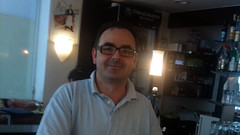 He was frustrated by a dark side of the wonderful and sunny Apulia (an italian region), where is really hard to find a decent job. So, he decided to travel up north like many others before: In the bag, he packed a creativity that is bringing him success. Thanks Salva for your help and for your delicious plates.
He was frustrated by a dark side of the wonderful and sunny Apulia (an italian region), where is really hard to find a decent job. So, he decided to travel up north like many others before: In the bag, he packed a creativity that is bringing him success. Thanks Salva for your help and for your delicious plates.
In the afternoon we meet Uli, making a fantastic interview: He freely speaks about his work with the boats on the river. We discover a man rich in ideas and moved an extraordinary passion and love. He gives me a wonderful oil lamp, that will warm and enlight my mind (next Diogenes!) in the darkness of the night.

Then, Uli’s dad takes us to the other side of the river, where Clodia’s moored.
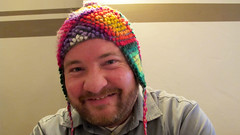 Late in the afternoon, we meet Holger, a local journalist from Hanau who read about our project in the newspaper and has contacted us through this website and Facebook. A nice interview and a few photos are enough to begin a friendship that will take him to join us aboard for a while, in a few days from now.
Late in the afternoon, we meet Holger, a local journalist from Hanau who read about our project in the newspaper and has contacted us through this website and Facebook. A nice interview and a few photos are enough to begin a friendship that will take him to join us aboard for a while, in a few days from now.
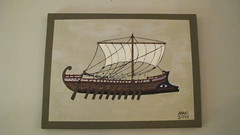 We’re now in the “Dionisos” restaurant, where we’re introduced to Naki, a greek man strong and happy, who carefully listens to what we do. He’s so kind to offer a turn of drinks at first and, of course, ouzo to end up. His nice drawings of Odysseus’ ship, hanging on the walls, reminds me that I’m a little Ulysses too, however missing a Penelope.
We’re now in the “Dionisos” restaurant, where we’re introduced to Naki, a greek man strong and happy, who carefully listens to what we do. He’s so kind to offer a turn of drinks at first and, of course, ouzo to end up. His nice drawings of Odysseus’ ship, hanging on the walls, reminds me that I’m a little Ulysses too, however missing a Penelope.
An Odysseus with no place where to have to get back, willing or not. In the evening I receive a message: We’re all invited to Uli’s place for dinner, the hero and his travel companions!
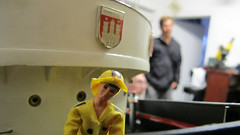 We have a wonderful time, enjoying the food made by a palestinian friend. Uli’s house is beautiful indeed, huge and full of bizarre items (ship and car models, old posters, uncanny machines), made even more gorgeous by a big dog and overall by his partner, a tall and strong humorous lady who immediately wins us.
We have a wonderful time, enjoying the food made by a palestinian friend. Uli’s house is beautiful indeed, huge and full of bizarre items (ship and car models, old posters, uncanny machines), made even more gorgeous by a big dog and overall by his partner, a tall and strong humorous lady who immediately wins us.
Veronique is a trainer in many energy-demanding fitness disciplines, such as thr Zumba, an aerobic dance that’s a fusion of many different styles and makes you burn something like 1.200 calories per hour (nearly as hard as rowing upstream!). Uli gives us a nice italian wine and tasty sweets, a delicious burst of comfort. Thanks Uli and Veronique (who, on top of that, the next day will also host Fine in their home). See you soon, dear friends!
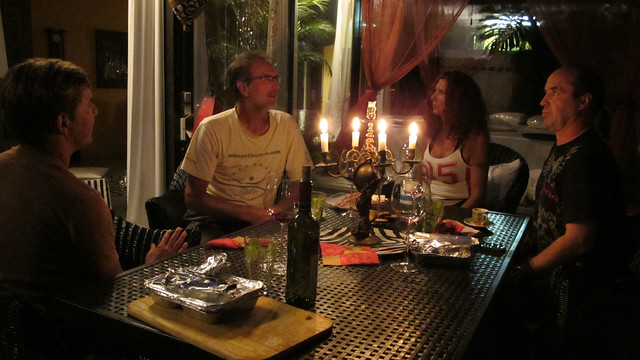
In the morning, a gift from the Gods comes upon us, this time straight from the Olympus. We had invited by Naki for a coffee: We manage to make it just in time and he’s already waiting for us, although a bit sleepy. We get to know his life, his passion for water and his Croatian wife with whom he also runs a pension near Dubrovnik.
After a nice coffe and a milkshake, his brother Achilleas comes to visit: He’s a Jiu-Jitsu fighter, training in a gymn nearby. Bruno is brown belt in brazilian Jiu-Jitsu too: How not to arrange a fight!
 The gymn is wonderful: Achilleas and Bruno are locked in combat. Bruno is out of training by 8 years, but by higher grade. Achillas, well trained and fit, learns. Watching them fighting is fantastic, they’re aggressive in a friendly way. It’s a tridimensional metaphor of war, a peaceful one though. Strange but true!
The gymn is wonderful: Achilleas and Bruno are locked in combat. Bruno is out of training by 8 years, but by higher grade. Achillas, well trained and fit, learns. Watching them fighting is fantastic, they’re aggressive in a friendly way. It’s a tridimensional metaphor of war, a peaceful one though. Strange but true!
In the end, we’re homaged with two nice jackets and a jumper.
Later, Naki gives us some delicoius Greek food. Olives, feta, hand made oregano’s bread. Greek water! A gift by Zeus and Naki. ????????? ????.
There’s still time to meet Michael, a canoe-builder, then we set off. We’re in for a very tough row, against a strong headwind and an even stronger current due to the heavy rainfalls. The Main valley gets stunnier mile by mile, hilly and rich in nature. Fir trees, larches and vineyards, many of them.

We letf later than scheduled, so we have to get rowing for a long while. When we arrive to Erlenbach am Main is nearly dark: We quickly spot an oxbow to moor. From a close boat, a woman comes handling a couple of beers and invites us aboard. Bianka and her husband Peter are travelling to Bamberg.
 She shows us a nice t-shirt depicting the Che, and cooks ravioli. We’re not missing beer, of course, lots of it since we’re in Bavaria. In the meantime, Peter plays the accordion: we have a good time tonight, as very often along the rivers. In the morning I ask him to play aboard Clodia, and his music gets through the water and to the fish. Marvel! Such as Mario Brunello before our (first) departure.
She shows us a nice t-shirt depicting the Che, and cooks ravioli. We’re not missing beer, of course, lots of it since we’re in Bavaria. In the meantime, Peter plays the accordion: we have a good time tonight, as very often along the rivers. In the morning I ask him to play aboard Clodia, and his music gets through the water and to the fish. Marvel! Such as Mario Brunello before our (first) departure.
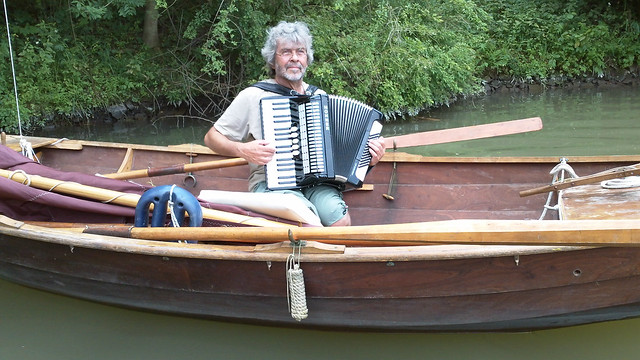
Then we go. Still headwind, stronger current, hard life for rowers. We take turns with each other.
The Main-Show is on. Valleys with vineyards nestled on dramatic cliffs, castles, pointed belltowers, fortified towns, forests and wheat, a showdown of colours that at sunset are hard to grasp, as it happens when you face true beauty.
 The river is clean, lively despite the cruise liners moving an impressive mass of water that eradicates everything on its way, including Clodia if we don’t take care.
The river is clean, lively despite the cruise liners moving an impressive mass of water that eradicates everything on its way, including Clodia if we don’t take care.
Poor Venice comes to my mind, thinking to the madness of cruise ships in the San Marco basin and in the Giudecca’s canal. It’s underwater, where you can’t see it, that the greatest damage takes place.
We greet Peter and Bianka, setting sails to Miltenberg, the pearl of the Main, where we’re awaited by Anja, a journalist. We still see many castles, ancient walls, a shipyard with a slipway on its side, suspended vineyards and so much green, in all its tones. Entering Miltenberg is a bit like getting to Disneyland, except that this city is real.
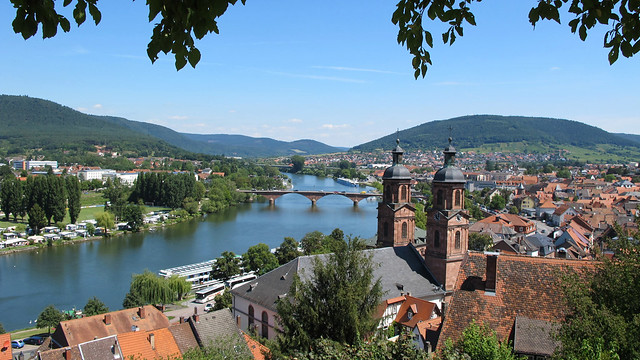
Anja greets us from the bank. And she helps us, after a quick sail, picking up Fine and her friend Tilmann (who’s come here to celebrate her birthday, happy birthday Fine!!!) in the train station. Tilmann will be our guest for a couple of days. In the evening Anja interviews us and takes some wonderful pictures.
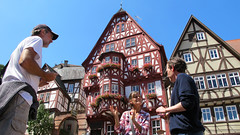 Miltenberg is quite amazing, with its decorated bavarian houses in the typical wood and brick structure, often by using the nice local pink stone.
Miltenberg is quite amazing, with its decorated bavarian houses in the typical wood and brick structure, often by using the nice local pink stone.
We have a peaceful night, dry at least, starting the next day with a rich breakfast with Anja and her friend Annette.
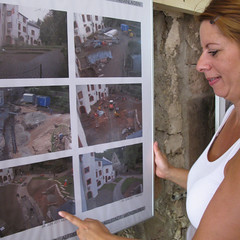 Annette studies food sciences (she’s a crudist believer) and she gives us plenty of marvels to eat!
Annette studies food sciences (she’s a crudist believer) and she gives us plenty of marvels to eat!
They take us for a tour of the city and the castle, telling us that the latter was in ruins up to 2006.
An important newspaper article written by Anja helped in finding the money necessary ro restore it: Now it’s an attraction bringing economy and culture to the city. In Miltenberg you can also see the world’s smallest theatre, a jewel. Less is more as usual.
Walking in the city, I meet a group of youth rowers, asking me so many things about our project and about the reasons taking us to Istanbul.
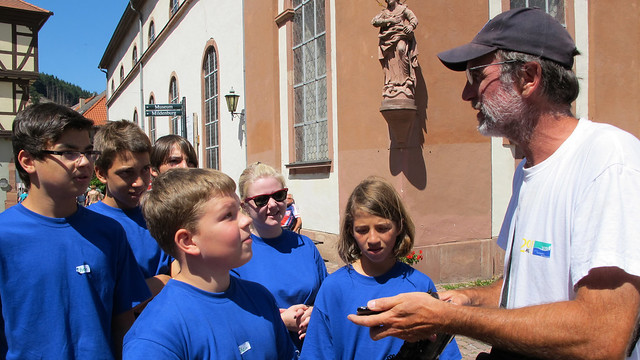
Fine and I leave Miltemberg reluctantly, while Bruno already set off to Wertheim, where we get in the evening. To be honest, we stop for the night about three Km before town, in a little port where we’re kindly hosted. We spend the rest of the day in a close Bier Garten (the famous beer gardens!) celebrating Holger’s arrival. Bruno is daring tonight and orders a mammooth-sized beer keg.
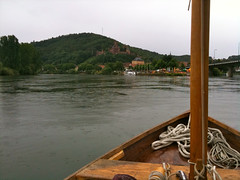 When we get to Wertheim, early in the morning, it’s rainy and windy. We moor and see Günter, a kind big man that we had already met a few days ago in a lock: he offers me a coffee and a wark breakfast.
When we get to Wertheim, early in the morning, it’s rainy and windy. We moor and see Günter, a kind big man that we had already met a few days ago in a lock: he offers me a coffee and a wark breakfast.
Werner the port’s captain, as often happens in our journey, grants us free mooring and helps me in connecting to the Internet from his house, that’s just in front of the dock.
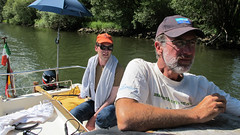 The rain makes the river stronger: I know what I’m in for. The rivers are made by water, so lots of water has to go downstream while we’re travelling upstream!
The rain makes the river stronger: I know what I’m in for. The rivers are made by water, so lots of water has to go downstream while we’re travelling upstream!
However, who strongly wanted this boat and this adventure?? “Silly old Giacomo,” – I say to myself – “so keep rowing and be quiet!”
A sad day comes for Fine and me, and for the all “Man on the River” crew. A great Man leaves us (temporarily, at least). Bruno has to get back to Brazil to take care about his boats, too long left alone to look after me and the project.
 He has given me a massive quantity of help, passion, suggestions and drunk a massive quantity of beer (only joking!!). I greet him just before weeping like a child while I leave him in the train station. It wasn’t for Bruno, and Fine, this year I would not have started the journey.
He has given me a massive quantity of help, passion, suggestions and drunk a massive quantity of beer (only joking!!). I greet him just before weeping like a child while I leave him in the train station. It wasn’t for Bruno, and Fine, this year I would not have started the journey.
The doctor gave me a sharp response, but Bruno loves taking risks, wisely and happily though.
And always with a smile in his face, even in the toughest moments, self confident and calm. Saint Bruno: That’s how I call him since our first project in 2006.
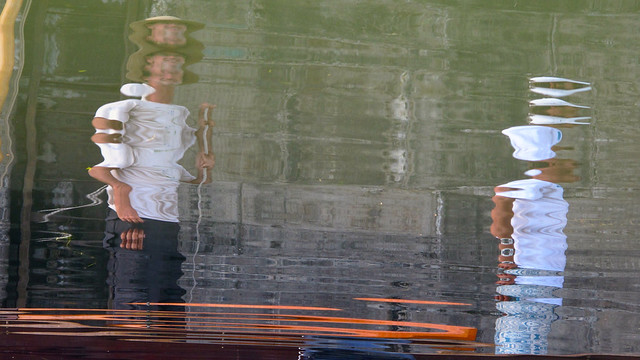
Muito obrigado Bruno, great friend of mine.
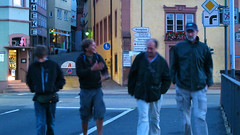 Paolo Muran, documentar’s director, comes along with his son Massimo, just in time to say goodbye to Bruno while the sky starts crying in solidarity. The journey must go ahead and the train too: The next day we set sails without Bruno and Fine, who has to undertake a couple of health check-ups (and Tilmann leaves with her).
Paolo Muran, documentar’s director, comes along with his son Massimo, just in time to say goodbye to Bruno while the sky starts crying in solidarity. The journey must go ahead and the train too: The next day we set sails without Bruno and Fine, who has to undertake a couple of health check-ups (and Tilmann leaves with her).
New crew, same mood. Less nautical experience but more spaghetti and coffee, not to mention that very soon a new friend will join us: He’s Enrico, a Scottish-Italian who’s riding with his bike all the way from Glasgow to Ukraine. “Se no i xe mati no li volemo” (If they aren’t crazy, we don’t want’em) as they say in Venice.
And the journey goes on.
A felicidade è como a gota
De orvalho numa petala de flor
Brilha tranquila
Depois de leve oscila
E cai como uma lagrima de amor
Happiness is like a drop
Of dew on a flower’s petal
It shines peacefully
then swings lightly
And falls like a tear of love
Vinicius de Moraes
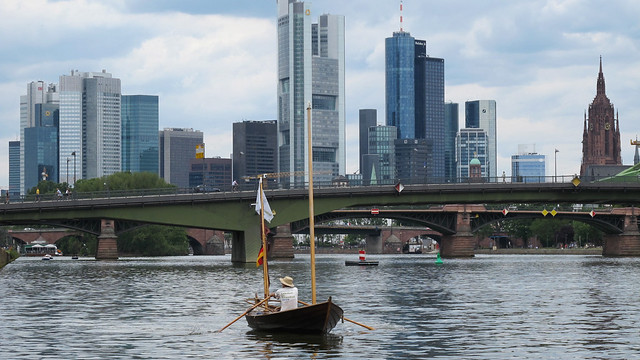
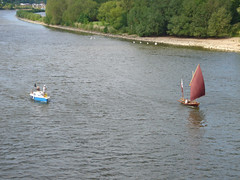 Despite this, we can see lots of wildlife, such as very big duck and swans, whose regal beauty would glorify even a less stunning scenery than the one on show here, resembling Altdorfer art.
Despite this, we can see lots of wildlife, such as very big duck and swans, whose regal beauty would glorify even a less stunning scenery than the one on show here, resembling Altdorfer art.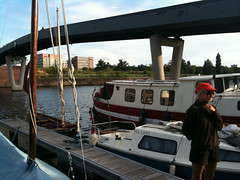 I follow him in a small garden where, seated on a bench, he writes me many things that I’m going to put into practice. I’ll tell you more soon: In the meantime I have to finish off that little food left into Clodia’s storeroom.
I follow him in a small garden where, seated on a bench, he writes me many things that I’m going to put into practice. I’ll tell you more soon: In the meantime I have to finish off that little food left into Clodia’s storeroom.
 One hundred metres away, on the right bank of the Main and in the midst of a crowd of people, I spot a bizarre boat bearing a familiar name: “Istanbul”.
One hundred metres away, on the right bank of the Main and in the midst of a crowd of people, I spot a bizarre boat bearing a familiar name: “Istanbul”.
 Just after the first lock, the rain comes: I see a sailboat in the distance and its captain, Johannes, comes close offering to pull me.
Just after the first lock, the rain comes: I see a sailboat in the distance and its captain, Johannes, comes close offering to pull me.
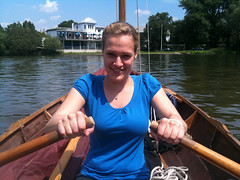 In the morning, miraculously, we wake up under a bright and warm sun, that dries our bones and everything that have got drenched the night before.
In the morning, miraculously, we wake up under a bright and warm sun, that dries our bones and everything that have got drenched the night before.
 Not even the time to dock (after taking a wrong turn and getting stuck) and we’re welcomed by a clone of Eddie Vedder, the legendary singer of Pearl Jam, in a pick-up truck. An open smile and very good, self-confident manners: He’s Jörn Lassig.
Not even the time to dock (after taking a wrong turn and getting stuck) and we’re welcomed by a clone of Eddie Vedder, the legendary singer of Pearl Jam, in a pick-up truck. An open smile and very good, self-confident manners: He’s Jörn Lassig.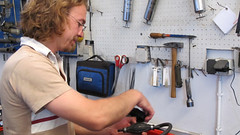 He takes us to his amazing workshop giving us a few spare parts for the temporary small engine used by Serena (the support boat steered by Fine).
He takes us to his amazing workshop giving us a few spare parts for the temporary small engine used by Serena (the support boat steered by Fine).  For free!! He doesn’t want any money at all! Fantastic Jörn! We invite him aboard for a beer and late in the evening, despite his busy agenda, he pays us a visit along with his lovely wife Silvia. We all have a good time, sharing many interests.
For free!! He doesn’t want any money at all! Fantastic Jörn! We invite him aboard for a beer and late in the evening, despite his busy agenda, he pays us a visit along with his lovely wife Silvia. We all have a good time, sharing many interests.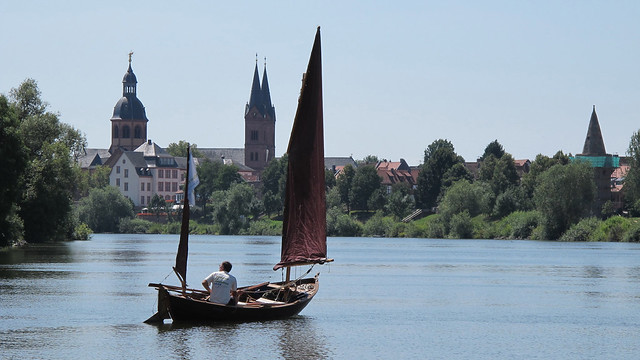
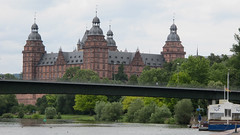 It had to be a very wealthy place.
It had to be a very wealthy place.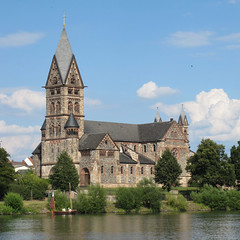 In the Aschaffenburg marina we get greeted by a man with a nice smile: I immediately know that we stumbled into one of our usual guardian angels. His name’s Uli Becker.
In the Aschaffenburg marina we get greeted by a man with a nice smile: I immediately know that we stumbled into one of our usual guardian angels. His name’s Uli Becker.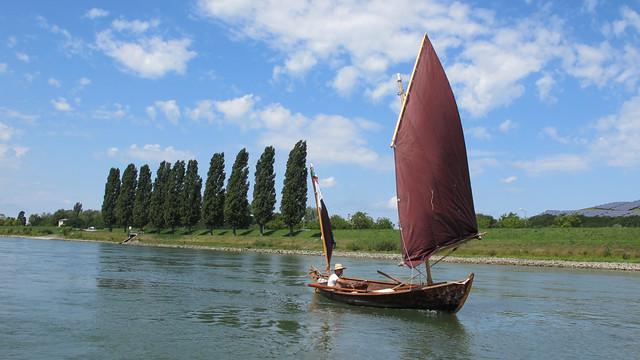
 First of all, I wish to thank Norbert and Lukas from the Cercle Nautique de l’Alsace du Nord, who, on top of granting Clodia free mooring, came to pick us up at the train station. Thank you very much indeed!
First of all, I wish to thank Norbert and Lukas from the Cercle Nautique de l’Alsace du Nord, who, on top of granting Clodia free mooring, came to pick us up at the train station. Thank you very much indeed! Our navigation gets on quietly, mostly by rowing with the occasional upwind sail, for about 61 km up to Speyer, where we meet once again Sandro and his sister, Sara, on their way back from Amsterdam. We stop in a very modern and efficient Marina, although surrounded by a rather disturbing urbanization.
Our navigation gets on quietly, mostly by rowing with the occasional upwind sail, for about 61 km up to Speyer, where we meet once again Sandro and his sister, Sara, on their way back from Amsterdam. We stop in a very modern and efficient Marina, although surrounded by a rather disturbing urbanization.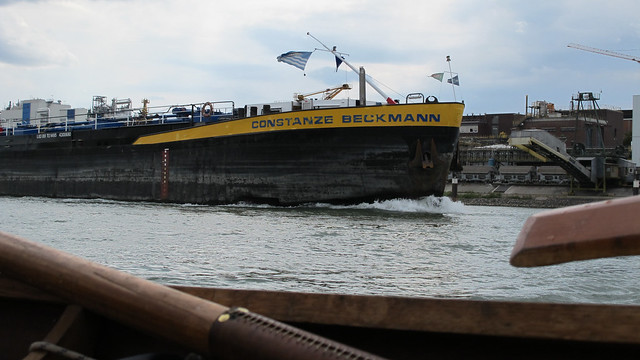
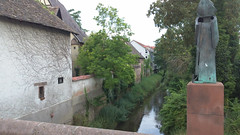 In Speyer we have a great evening with Sandro and Sara, indulging in a culinary escapade in a restaurant called “Porto Vecchio Veneziano” (The Old Venetian Harbour). We’re very tired and hungry after so many kilometers rowed under a blazing sun, so we surrender once more to the consumer society.
In Speyer we have a great evening with Sandro and Sara, indulging in a culinary escapade in a restaurant called “Porto Vecchio Veneziano” (The Old Venetian Harbour). We’re very tired and hungry after so many kilometers rowed under a blazing sun, so we surrender once more to the consumer society.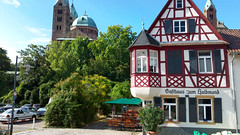 And we consume, frugally, but we consume, and paying for it of course. Early in the morning I go for a quick tour of the city of Speyer, that’s quite nice: Its big cathedral (“Kaiserdom”) is listed as World Heritage Site by the Unesco. It houses the tombs of eight kings of Germany, four of which being emperors of the Holy Roman Empire too.
And we consume, frugally, but we consume, and paying for it of course. Early in the morning I go for a quick tour of the city of Speyer, that’s quite nice: Its big cathedral (“Kaiserdom”) is listed as World Heritage Site by the Unesco. It houses the tombs of eight kings of Germany, four of which being emperors of the Holy Roman Empire too.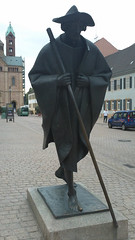 Then I visit a monastery dating 1228, where I find a plaque remembering Edith Stein, religious and philosopher dead in Auschwitz in 1942. Suddenly, a pleasant surprise: The monument to Jakob, a pilgrim of the 14th century who has reached Santiago of Compostela by foot: You can see how light he was travelling! An applause to him: Less is more.
Then I visit a monastery dating 1228, where I find a plaque remembering Edith Stein, religious and philosopher dead in Auschwitz in 1942. Suddenly, a pleasant surprise: The monument to Jakob, a pilgrim of the 14th century who has reached Santiago of Compostela by foot: You can see how light he was travelling! An applause to him: Less is more.
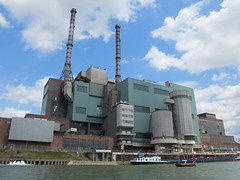 By the river, Mannheim looks huge. Here, in 1868, was stipulated the Convention on the Navigation of the Rhine that still applies.
By the river, Mannheim looks huge. Here, in 1868, was stipulated the Convention on the Navigation of the Rhine that still applies. 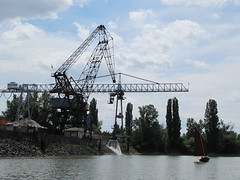 Our evening gets by in front of a good beer and under a line of plane trees reminding me of France.
Our evening gets by in front of a good beer and under a line of plane trees reminding me of France. I very much prefer ferries over bridges (such as the mast-chomping ones, specialized on damaging boats led by stupid sailors…).
I very much prefer ferries over bridges (such as the mast-chomping ones, specialized on damaging boats led by stupid sailors…).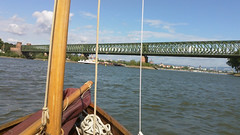 The next day, 4th of navigation along the Rhine, will take us to Mainz, after a 36 km run.
The next day, 4th of navigation along the Rhine, will take us to Mainz, after a 36 km run. 
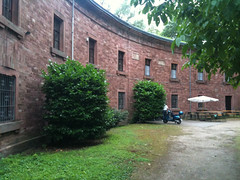 Soon after, commodore Harald comes to visit: He was already aware of our journey and we’re quickly invited to the monthly Club meeting, to tell the full story.
Soon after, commodore Harald comes to visit: He was already aware of our journey and we’re quickly invited to the monthly Club meeting, to tell the full story.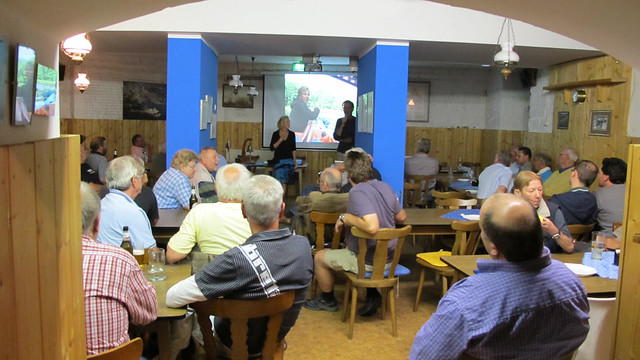
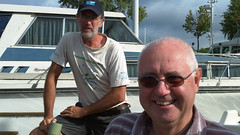 The night is rainy but I sleep like a log under my tent. In the morning the rain has gone, although a nasty wind sweeps up. A friend met last night, Winfried, comes to tell us that the museum where a few roman ships (found in the Rhine) are kept, is closed until September. We’re not the first ones rowing up here.
The night is rainy but I sleep like a log under my tent. In the morning the rain has gone, although a nasty wind sweeps up. A friend met last night, Winfried, comes to tell us that the museum where a few roman ships (found in the Rhine) are kept, is closed until September. We’re not the first ones rowing up here.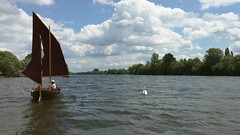 I’m thrilled, the Main is near. Still 2 km on the Rhine then I turn right, raise the two sails and begin an exhilarating, wind-powered flight of 35 km (aside a couple of km through a meander). Just three locks, very easy to pass, slow us down. One of them even has a reduced lock for small boats. What a beauty!
I’m thrilled, the Main is near. Still 2 km on the Rhine then I turn right, raise the two sails and begin an exhilarating, wind-powered flight of 35 km (aside a couple of km through a meander). Just three locks, very easy to pass, slow us down. One of them even has a reduced lock for small boats. What a beauty!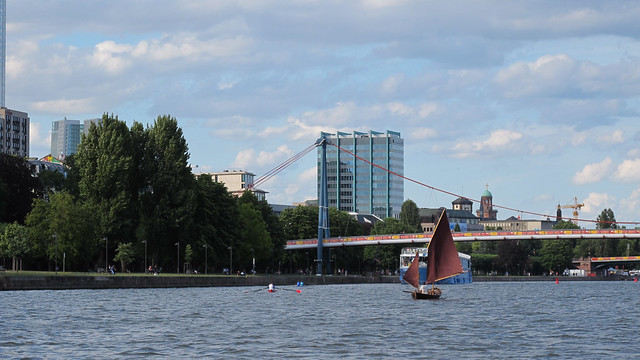
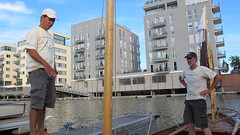 We’re in a very modern suburb of Frankfurt, housing a Marina nestled within an urban plan designed to recover the old docks.
We’re in a very modern suburb of Frankfurt, housing a Marina nestled within an urban plan designed to recover the old docks. The Sailing Club hosting us is wonderful and today we’ll make a video of the many people navigating along the river.
The Sailing Club hosting us is wonderful and today we’ll make a video of the many people navigating along the river.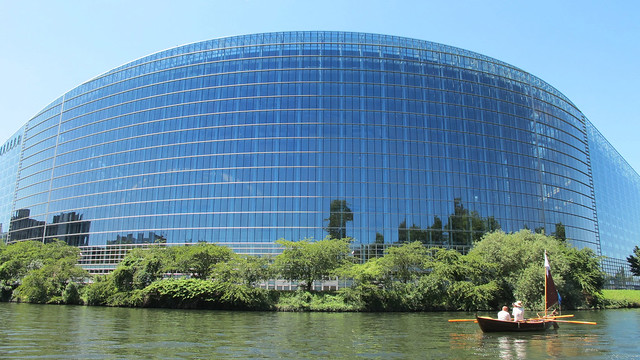
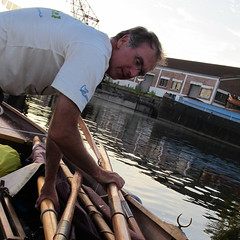 On the opposite, the uncertainty of travelling forces us to look at the world with new eyes, so other people reflect themselves in what you do and what you feel.
On the opposite, the uncertainty of travelling forces us to look at the world with new eyes, so other people reflect themselves in what you do and what you feel. We enjoy a good sleep moored side by side to Rataka, the housboat of Remy and Nadash. At 6 o’clock I neak out to find bread and croissants for Fine, Bruno and me, finding a nice boulangerie in the heart of Vendenheim. At noon, the mayor picks us up for lunch, along with his wife and daughter in law (his son works in Boulogne sur Mer, surveilling the English Channel).
We enjoy a good sleep moored side by side to Rataka, the housboat of Remy and Nadash. At 6 o’clock I neak out to find bread and croissants for Fine, Bruno and me, finding a nice boulangerie in the heart of Vendenheim. At noon, the mayor picks us up for lunch, along with his wife and daughter in law (his son works in Boulogne sur Mer, surveilling the English Channel).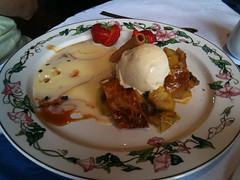 Alsatian cuisine is rich and interesting, too tasty to waste any time in describing it: I have to concentrate on eating like a pig! My dish resembles a bit a Piedmontese recipe, brasato al Barolo, made of savoury meats and French sauces. Fine and Bruno have sauerkrauts and potatoes, with sausages, würstels and well-cooked pork, quite tasty indeed.
Alsatian cuisine is rich and interesting, too tasty to waste any time in describing it: I have to concentrate on eating like a pig! My dish resembles a bit a Piedmontese recipe, brasato al Barolo, made of savoury meats and French sauces. Fine and Bruno have sauerkrauts and potatoes, with sausages, würstels and well-cooked pork, quite tasty indeed.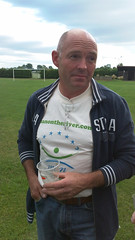 In the meantime we’ve been reached by a much appreciated guest, Karl (Kalle) Fine’s dad, just arrived from Hannover to stay a few days with us.
In the meantime we’ve been reached by a much appreciated guest, Karl (Kalle) Fine’s dad, just arrived from Hannover to stay a few days with us. Kalle, nice and strong, has a wonderful job: He works on landscape art, building fabulous and poetical fences and many other objects by using willow timber and other materials that nature has to offer. In the evening we take a walk to Vendenheim, passing maize fields and big cherry trees.
Kalle, nice and strong, has a wonderful job: He works on landscape art, building fabulous and poetical fences and many other objects by using willow timber and other materials that nature has to offer. In the evening we take a walk to Vendenheim, passing maize fields and big cherry trees.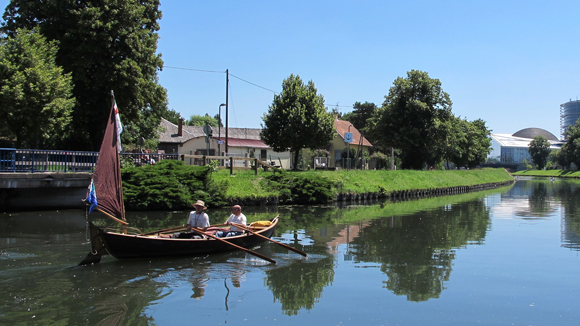
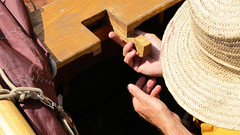 Thanksfully the main traveller of Clodia and the mast lock was wisely built by Roland in such a way to break immediately, avoiding further damages to the structure to the hull in cause of collision with a bridge.
Thanksfully the main traveller of Clodia and the mast lock was wisely built by Roland in such a way to break immediately, avoiding further damages to the structure to the hull in cause of collision with a bridge.
 We enter Strasbourg at 2 a’clock of a sticky hot sunday, over 33°C of temperature. We row in front of the European Parliament and its technological show-off: I have to think about all the money that many members of the parliament earn (an Italian member could receive as much as 35.000 EURO per month) while so many people, often more capable, struggle with very low wages. Efficient politicians do exist, but they’re rare birds. I wonder why.
We enter Strasbourg at 2 a’clock of a sticky hot sunday, over 33°C of temperature. We row in front of the European Parliament and its technological show-off: I have to think about all the money that many members of the parliament earn (an Italian member could receive as much as 35.000 EURO per month) while so many people, often more capable, struggle with very low wages. Efficient politicians do exist, but they’re rare birds. I wonder why.
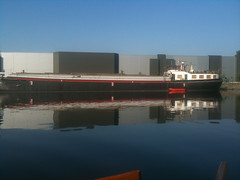 When I get close, she shows me a copy of the DNA (Derniere Nouvelles Alsaciennes), a newspaper with an article written about us and a nice picture of Clodia. Her boat is called Labor and is very big, 55 by 6 mt.: Anne, smiling, kindly invites me to jump aboard for a coffee. How nice, I’m happy to accept. To get on board I have to climb about 3 metres: Much different scales compared with those Peniche on the canals.
When I get close, she shows me a copy of the DNA (Derniere Nouvelles Alsaciennes), a newspaper with an article written about us and a nice picture of Clodia. Her boat is called Labor and is very big, 55 by 6 mt.: Anne, smiling, kindly invites me to jump aboard for a coffee. How nice, I’m happy to accept. To get on board I have to climb about 3 metres: Much different scales compared with those Peniche on the canals. There, I discover a wonderful house and meet Toni, Anne’s partner, who welcomes me. I enjoy a nice coffee and an even nicer conversation with my hosts. Anne and Toni’s business is about culture and their peniche is a huge atelier.
There, I discover a wonderful house and meet Toni, Anne’s partner, who welcomes me. I enjoy a nice coffee and an even nicer conversation with my hosts. Anne and Toni’s business is about culture and their peniche is a huge atelier.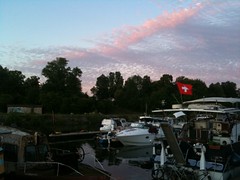 The “liveaboard” community is quite large and quickly welcomes me. The little harbour is pleasant and protected, close to the citadel. As always, we’ll get generously offered free mooring for the two days of stay with Clodia.
The “liveaboard” community is quite large and quickly welcomes me. The little harbour is pleasant and protected, close to the citadel. As always, we’ll get generously offered free mooring for the two days of stay with Clodia.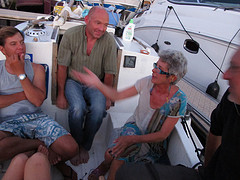 Helene, a theatrical costumes designer, is a charming woman living aboard by six years: unfortunately her beautiful steel boat, dating 1908, has sunk for unknown reasons.
Helene, a theatrical costumes designer, is a charming woman living aboard by six years: unfortunately her beautiful steel boat, dating 1908, has sunk for unknown reasons.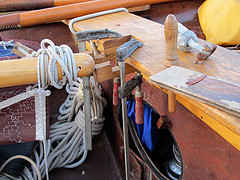 Our day will be as full as usual: We’re waited by many interviews and fixings on Clodia. Yesterday Bruno took care of the most of it however the bulkead has still to be repaired.
Our day will be as full as usual: We’re waited by many interviews and fixings on Clodia. Yesterday Bruno took care of the most of it however the bulkead has still to be repaired. I try to sleep a little in the shadow of a boat, but a woman comes to tell me her interesting story aboard the Glass Boat belonging to Alexandre, master glassmaker. How nice these tales of people that, regardless of age, build a new life. Alexander for instance was a truck driver, but when he turned 50 he decided to change.
I try to sleep a little in the shadow of a boat, but a woman comes to tell me her interesting story aboard the Glass Boat belonging to Alexandre, master glassmaker. How nice these tales of people that, regardless of age, build a new life. Alexander for instance was a truck driver, but when he turned 50 he decided to change. Even inside, the heat is terrible and our “political” day gets quite tiring, however still full of energy and passion. The interview is interesting and intense: We discover the environmental strategies of Strasbourg and I get the impression that Ms Buchmann is a truly passionate and dedicated administrator. Please come to Strasbourg to take a look.
Even inside, the heat is terrible and our “political” day gets quite tiring, however still full of energy and passion. The interview is interesting and intense: We discover the environmental strategies of Strasbourg and I get the impression that Ms Buchmann is a truly passionate and dedicated administrator. Please come to Strasbourg to take a look.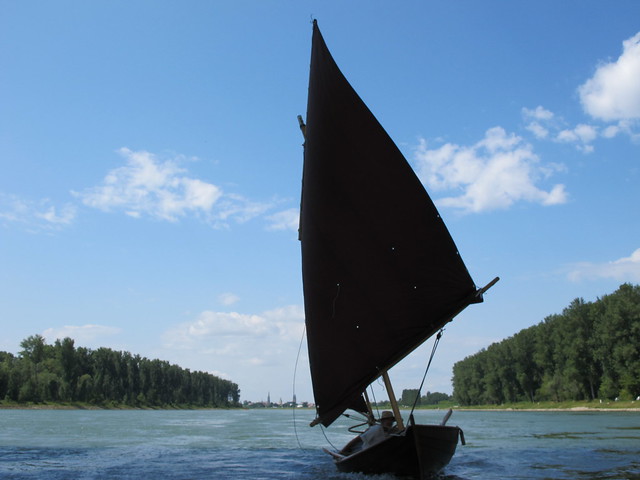

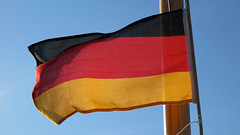 Our Alsatian adventure begun in the Vosges: Language, architecture, flavours had changed. However, at this stage I was really convinced to have landed to Germany, but I’m still in France. So what can we say?
Our Alsatian adventure begun in the Vosges: Language, architecture, flavours had changed. However, at this stage I was really convinced to have landed to Germany, but I’m still in France. So what can we say?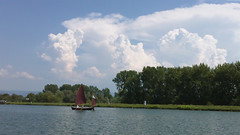 That’s Europe and I’m becoming ever more convinced that the borders were drawn by people either crazy or drunk.
That’s Europe and I’m becoming ever more convinced that the borders were drawn by people either crazy or drunk.
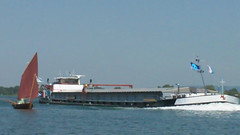 So far the waves are keeping low, we face an opposite yet weak wind and the big barges are fast enough (about 20 Km/h) but very open-eyed on us as we’re on them.
So far the waves are keeping low, we face an opposite yet weak wind and the big barges are fast enough (about 20 Km/h) but very open-eyed on us as we’re on them.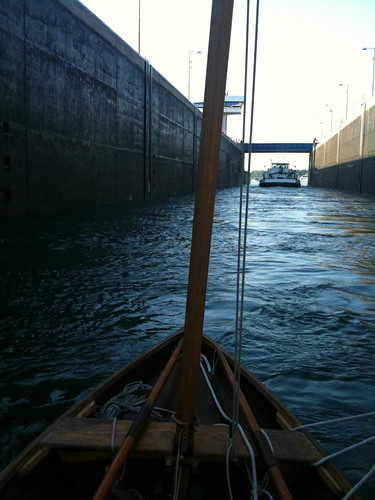
 We look like a mice in an elephant dance party, but these elephants know how to spin.
We look like a mice in an elephant dance party, but these elephants know how to spin.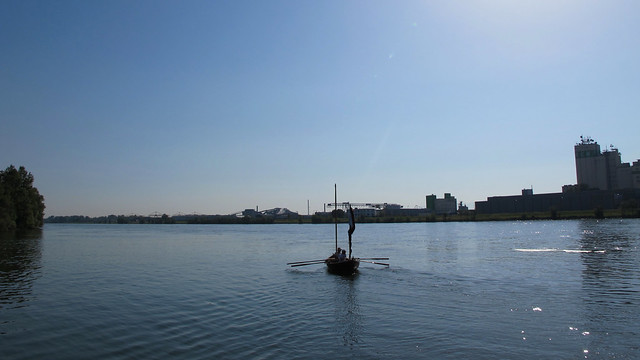
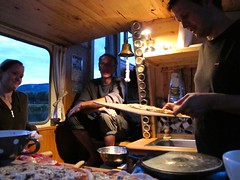 We stopped for two days in Saverne, lovely city, where we’ve been invited for a pizza on the holyday-boat of a nice German couple, Volker and Ilka. Their pizza was beautiful such as their hospitality aboard Grønland, a Dutch Tijalk (a flat bottomed boat) that they’ve completely restored.
We stopped for two days in Saverne, lovely city, where we’ve been invited for a pizza on the holyday-boat of a nice German couple, Volker and Ilka. Their pizza was beautiful such as their hospitality aboard Grønland, a Dutch Tijalk (a flat bottomed boat) that they’ve completely restored. 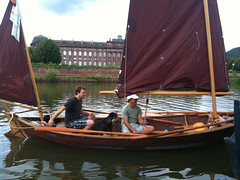 The morning after, Bruno takes Volker aboard Clodia for a sail in the basin facing the wonderful 17th century palace, the Chateau of Saverne, whose majesty has earned it the name “Versailles Alsace“.
The morning after, Bruno takes Volker aboard Clodia for a sail in the basin facing the wonderful 17th century palace, the Chateau of Saverne, whose majesty has earned it the name “Versailles Alsace“.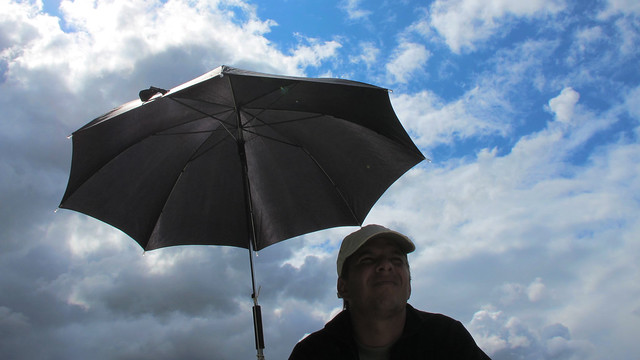
 To reach the city we have to cross as much as 4 waterways in 1 km, a sort of word record!
To reach the city we have to cross as much as 4 waterways in 1 km, a sort of word record!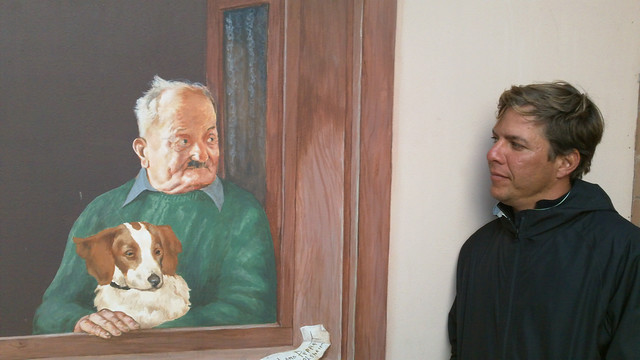
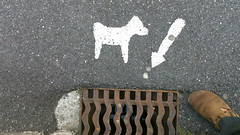 On the walls we see strange paintings of people looking out of the window, and ground signs telling manholes may be used as dog toilets. These clues lead to a conclusion: French mind-set has never worked very well here. After all the majority of surnames is German and everyone is bilingual, since Alsace was Germany for a long time.
On the walls we see strange paintings of people looking out of the window, and ground signs telling manholes may be used as dog toilets. These clues lead to a conclusion: French mind-set has never worked very well here. After all the majority of surnames is German and everyone is bilingual, since Alsace was Germany for a long time. The fist is called Henri Bronner, mayor of Vendenheim and friend of Guy Rougieux. He’s so kind to come to pick us up at 9 o’clock in the morning in Hochfelden, displaying Alsatian punctuality (5 to 7 minutes away from that of Germany, which in turn follows by 5 minutes the Swiss one, unchallenged even by Japanese).
The fist is called Henri Bronner, mayor of Vendenheim and friend of Guy Rougieux. He’s so kind to come to pick us up at 9 o’clock in the morning in Hochfelden, displaying Alsatian punctuality (5 to 7 minutes away from that of Germany, which in turn follows by 5 minutes the Swiss one, unchallenged even by Japanese). Dr Samir Idir shows to Fine and me this technological marvel that gives back water to the big river, who’s seriously ill and therefore under strict observation by the European Community.
Dr Samir Idir shows to Fine and me this technological marvel that gives back water to the big river, who’s seriously ill and therefore under strict observation by the European Community.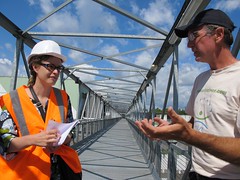 The left-overs of depuration are used to produce natural gas, in such an extent that from next year the plant will be self-sufficient for heat energy and really soon for electricity too (they’re even planning to sell the energy surplus).
The left-overs of depuration are used to produce natural gas, in such an extent that from next year the plant will be self-sufficient for heat energy and really soon for electricity too (they’re even planning to sell the energy surplus). Later on, we are introduced to
Later on, we are introduced to  We then go to Vendenheim, where we visit the city hall, an enviable Senior Citizens’ Centre and a sport centre built by using the latest and best energy saving technologies. A dream made real.
We then go to Vendenheim, where we visit the city hall, an enviable Senior Citizens’ Centre and a sport centre built by using the latest and best energy saving technologies. A dream made real.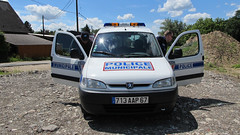 To get back to Hochfelden, where Clodia is moored, we get a lift from Damien, a policeman from Vendenheim.
To get back to Hochfelden, where Clodia is moored, we get a lift from Damien, a policeman from Vendenheim.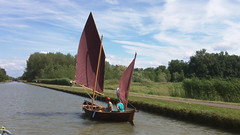 Bruno (who stayed to look after the boat) is impatiently waiting for us, because the wind is strong enough to set sails. We get going very quickly, with Bruno at the tiller and Fine rowing, covering 18 km in 5 hours: Just in time to arrive to Vendenheim where we stop for two days, shaded by a wonderful Dutch boat.
Bruno (who stayed to look after the boat) is impatiently waiting for us, because the wind is strong enough to set sails. We get going very quickly, with Bruno at the tiller and Fine rowing, covering 18 km in 5 hours: Just in time to arrive to Vendenheim where we stop for two days, shaded by a wonderful Dutch boat. It’s the house of Remy, lock-keeper of the first “ecluse” on the Rhine after Strasbourg. Remy and his wife Nadash, a bycicle postwoman, offer us a hot shower and a tasty dinner, where we’re entertained by stories about the lock and the big river. Their daughter Marine even draws a lovely picture of us that you can see below!
It’s the house of Remy, lock-keeper of the first “ecluse” on the Rhine after Strasbourg. Remy and his wife Nadash, a bycicle postwoman, offer us a hot shower and a tasty dinner, where we’re entertained by stories about the lock and the big river. Their daughter Marine even draws a lovely picture of us that you can see below!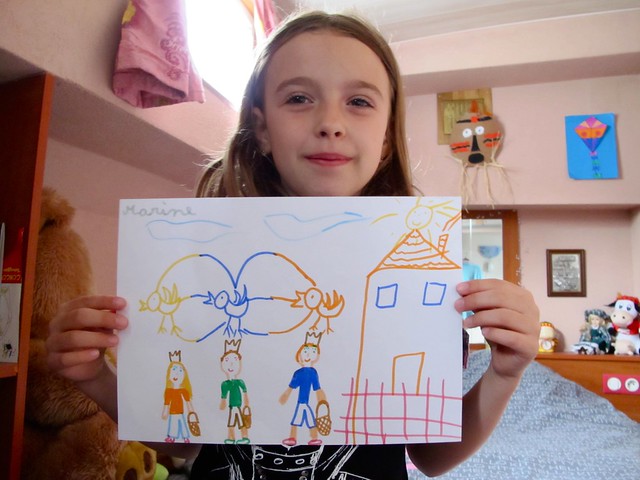

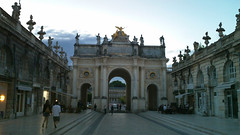 We left our story in the outskirts of Nancy: At first glance I really liked this city. I can now confirm and reinforce the enthusiasm for a community that seems very committed in preserving the environment and offering a good lifestyle to all its citizens, beginning from the means of moving.
We left our story in the outskirts of Nancy: At first glance I really liked this city. I can now confirm and reinforce the enthusiasm for a community that seems very committed in preserving the environment and offering a good lifestyle to all its citizens, beginning from the means of moving. The network of public transport is well-distributed and the electric tram reaches most of the suburbs. Methane fueled buses and a well managed traffic make of Nancy a very clean and pleasant city. We’re welcomed by Sylvain, who works and studies here. He speaks a good English, however we strive to speak French.
The network of public transport is well-distributed and the electric tram reaches most of the suburbs. Methane fueled buses and a well managed traffic make of Nancy a very clean and pleasant city. We’re welcomed by Sylvain, who works and studies here. He speaks a good English, however we strive to speak French. 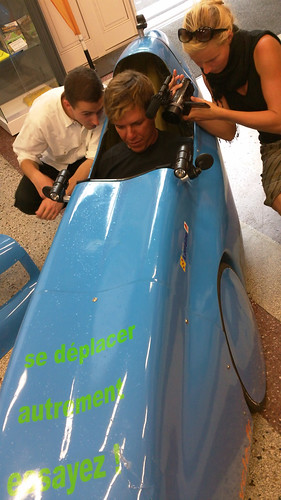 His hospitality and help have revealed priceless, beginning from
His hospitality and help have revealed priceless, beginning from 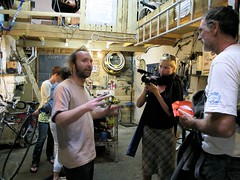 Thomas also organises events and tours, and the lab in rue des Tiercelins 18, can be freely used by all members to fix their bikes. A good idea worth to be followed.
Thomas also organises events and tours, and the lab in rue des Tiercelins 18, can be freely used by all members to fix their bikes. A good idea worth to be followed. The next day Paul takes us to meet his uncle Guy Rougieux, president of the syndicate of waters from the Seille and Moselle rivers. Guy has spent many years working on the water-supply system for the villages around Nancy. We follow him in a plateau housing a very interesting network: Here we visit a central where chlorine is added to drinking water by law, following the events of 2001 and the fear for terrorist attacks.
The next day Paul takes us to meet his uncle Guy Rougieux, president of the syndicate of waters from the Seille and Moselle rivers. Guy has spent many years working on the water-supply system for the villages around Nancy. We follow him in a plateau housing a very interesting network: Here we visit a central where chlorine is added to drinking water by law, following the events of 2001 and the fear for terrorist attacks. 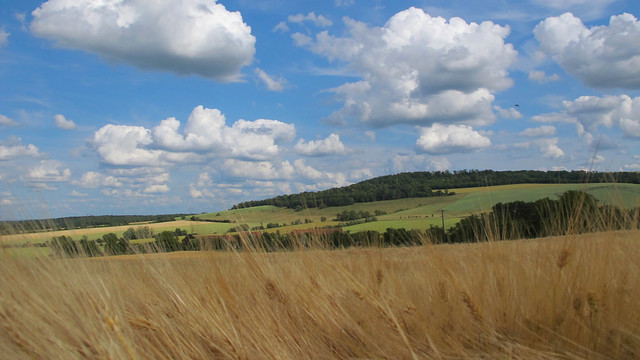
 Guy’s help is precious and will be even more important very soon: We develop a very strong friendship. In the evening we’re invited for dinner in his home in Lanfroincourt, 130 inhabitants, where we also visit La Pepiniere (the plant-nursery) of Etienne, Paul’s dad, and pick the same cherries used to make Paul’s mum’s jam. Paul tells us about the current hard times for quality plant-nurseries in Lorraine, after the invasion of low-cost plants.
Guy’s help is precious and will be even more important very soon: We develop a very strong friendship. In the evening we’re invited for dinner in his home in Lanfroincourt, 130 inhabitants, where we also visit La Pepiniere (the plant-nursery) of Etienne, Paul’s dad, and pick the same cherries used to make Paul’s mum’s jam. Paul tells us about the current hard times for quality plant-nurseries in Lorraine, after the invasion of low-cost plants.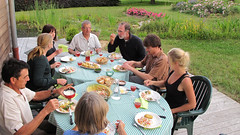 The dinner cooked by René, the nice wife of Guy, is special, full of delicious Lorraine specialties such as the Pâté Lorrain and the classic Quiche Lorraine. In the end Guy gives us a Mirabelle Brandy and René some magic cherries.
The dinner cooked by René, the nice wife of Guy, is special, full of delicious Lorraine specialties such as the Pâté Lorrain and the classic Quiche Lorraine. In the end Guy gives us a Mirabelle Brandy and René some magic cherries. The morning after, in the Port de Plaisance of Nancy we meet the director, Captain Franck Rosseaux, who tells us about this showpiece harbour and his commitment to protect the environment through initiatives aimed to reduce the waste of water and the leakage of bilge water and greywater (collecting them for free).
The morning after, in the Port de Plaisance of Nancy we meet the director, Captain Franck Rosseaux, who tells us about this showpiece harbour and his commitment to protect the environment through initiatives aimed to reduce the waste of water and the leakage of bilge water and greywater (collecting them for free).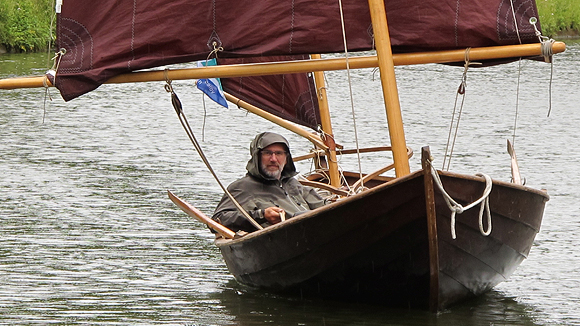
 In Varangeville, site of the famous salt mines, despite the heavy rain I approach a Peniche showing my best smile and asking for a good coffee shop.
In Varangeville, site of the famous salt mines, despite the heavy rain I approach a Peniche showing my best smile and asking for a good coffee shop. Quite soon, in the usual cozy and warm way of people who live aboard, we get feed with a substantial breakfast and guided for a tour of Saint Nicolas de Port.
Quite soon, in the usual cozy and warm way of people who live aboard, we get feed with a substantial breakfast and guided for a tour of Saint Nicolas de Port.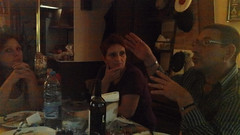 Anouk and her husband Dany also makes us dinner and we get overwhelmed by their warmth and friendliness. We have a wonderful time: Thanks Anouk and Dany, you gave us a special day to remember. The next morning the sun pops out and we get moving greeting our hosts with the usual sadness.
Anouk and her husband Dany also makes us dinner and we get overwhelmed by their warmth and friendliness. We have a wonderful time: Thanks Anouk and Dany, you gave us a special day to remember. The next morning the sun pops out and we get moving greeting our hosts with the usual sadness. She tells us the story of the town of Dombasle and its abandoned harbour, victim of the obtuseness of politics and of the vandals that have wasted a structure that could have been of great help for this area. Here there is a Solvay big industrial plant, who might have limited the long term view of the governants.
She tells us the story of the town of Dombasle and its abandoned harbour, victim of the obtuseness of politics and of the vandals that have wasted a structure that could have been of great help for this area. Here there is a Solvay big industrial plant, who might have limited the long term view of the governants. After Dombasle, Clodia, Bruno and me enjoy exhilarating sails under a continuous rain followed by moments of sunshine: It’s a very Atlantic looking weather with sudden changes. In Lagarde we sleep in a lovely harbour, passing the evening in conversation about life.
After Dombasle, Clodia, Bruno and me enjoy exhilarating sails under a continuous rain followed by moments of sunshine: It’s a very Atlantic looking weather with sudden changes. In Lagarde we sleep in a lovely harbour, passing the evening in conversation about life. After a great sail helped by 40 km/h windblasts, we reach and pass the lock of Richecourt, who was for many years the highest French lock, from its 15.4 metres of height.
After a great sail helped by 40 km/h windblasts, we reach and pass the lock of Richecourt, who was for many years the highest French lock, from its 15.4 metres of height. But never say never. The next day two friendly employed from VNF, our notorious guardian angels, after hearing me whining against the refuse coming from Strasbourg headquarter, decide to go to Nederviller by boat. They’ll try to plead the cause of our humble oar’s crusade in the local VNF office: Not an easy task.
But never say never. The next day two friendly employed from VNF, our notorious guardian angels, after hearing me whining against the refuse coming from Strasbourg headquarter, decide to go to Nederviller by boat. They’ll try to plead the cause of our humble oar’s crusade in the local VNF office: Not an easy task.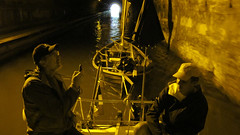 When they come back the no becomes a yes, assuming to get towed by an engine boat. Giving that the total distance to be covered is no longer than 6 km, we’re happy to accept this offer: Moreover any other means of transport would have been very hard to arrange and against our philosophy. So little Serena tows us.
When they come back the no becomes a yes, assuming to get towed by an engine boat. Giving that the total distance to be covered is no longer than 6 km, we’re happy to accept this offer: Moreover any other means of transport would have been very hard to arrange and against our philosophy. So little Serena tows us.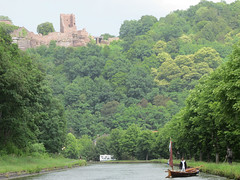 After Saint-Louis Arzviller we enter a completely different world: Beech and coniferous forests, red rocks, castles, german architecture, a steep descent to Strasbourg. We’re in the Vosges.
After Saint-Louis Arzviller we enter a completely different world: Beech and coniferous forests, red rocks, castles, german architecture, a steep descent to Strasbourg. We’re in the Vosges.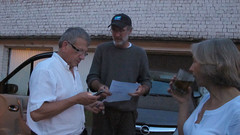 But I’m safe, it’s Guy who carries good news: He’s sold his soul to give us some interesting contacts in Strasbourg, where he has worked for many years and knows lots of people. He already arranged us a meeting with the mayor of a village who will be of great help. Guy is a saint who gave us help and passion. We’re touched, thanks.
But I’m safe, it’s Guy who carries good news: He’s sold his soul to give us some interesting contacts in Strasbourg, where he has worked for many years and knows lots of people. He already arranged us a meeting with the mayor of a village who will be of great help. Guy is a saint who gave us help and passion. We’re touched, thanks. Our journey so far has seen 200 locks, 8 tunnels, 13 suspended canals and we’re approaching the milestone of 1000 km, about 1/5th of the total itinerary.
Our journey so far has seen 200 locks, 8 tunnels, 13 suspended canals and we’re approaching the milestone of 1000 km, about 1/5th of the total itinerary.
 The mood is high and the bones wet. But water is life and local beer is also very tasty. We’re in Alsace, by the way, and wines are excellent too! In short, cheer up to fluids.
The mood is high and the bones wet. But water is life and local beer is also very tasty. We’re in Alsace, by the way, and wines are excellent too! In short, cheer up to fluids.






















